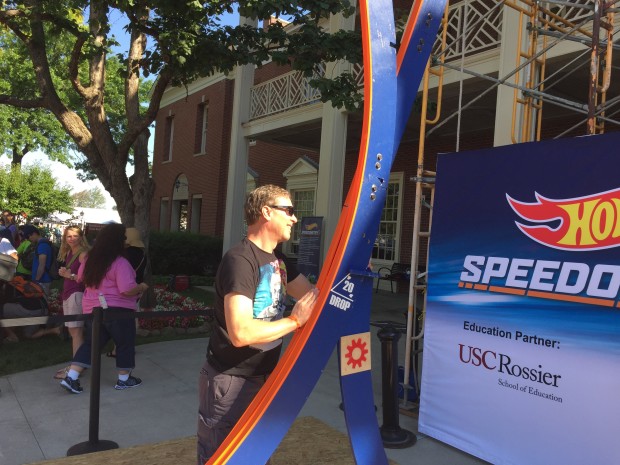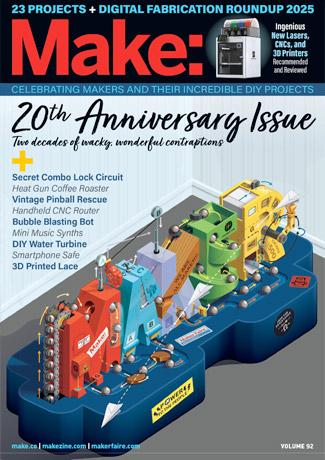

DETROIT—When you are trying to send Hot Wheels cars through a giant loop, you can tell you’re getting a good run by the sound. If it’s consistent and quiet, like a drop of water sizzling on a hot skillet, you’ve got a shot to make the loop. When you hear scraping or it’s loud, you know it’s not working right.
It takes a lot of Hot Wheels to get it to work right.
That was one takeaway from watching the first run of the giant Hot Wheels loop installation at the Maker Faire in Detroit this weekend. Grant Compton had walked up the steps of a large scaffold and winched up a big bag of Hot Wheels. Then he sent them down the track, one at a time. After about 10 tries, one of the cars made it through. Quietly.
Compton, an interiors designer at Ford, and his coworker John Jaranson, a research engineer at Ford, explained to me the physics of building their record-setting loop.
While the loop itself is made of standard Hot Wheels orange track, the feeder ramp leading into the loop is actually special aluminum track made by Hot Wheels’ manufacturer, Mattel. Compton told me Mattel is actually thinking of selling this track in the future.
The advantage of the aluminum track is that it’s much more thermally stable than the plastic track. In the hot July sun in Detroit, that matters. The 12 -and-1/2-foot loop, made of plastic track mounted to laser-cut, dovetailed wooden mounting rings, couldn’t be used when I arrived at the track setup first thing in the morning, since the track hadn’t yet warmed up and expanded to its daytime length.

When it did, Compton sent the cars through the loop. Earlier I had asked him if he’d done the math to know if the cars would make it through an even bigger loop. He believes it’s possible. The terminal velocity of a Hot Wheels car is about 40 miles per hour, he believes, based on weight, rolling friction, and air resistance. The current setup doesn’t get the cars quite up to that speed.
The loop shape could also be modified to reduce g force-induced friction. The loop is now round, unlike the loop-the-loops you see on roller coasters in amusement parks, which have a tear-drop shape. Technically it’s a clothoid loop, and that shape keeps the g forces on riders manageable. Since Hot Wheels have no riders, such an accommodation isn’t necessary. Furthermore, this loop was made to break a record for biggest Hot Wheels loop, which it did. But the diameter of a clothoid varies, which would have made the discussions with the record-keeping people complicated.
The record this new loop broke, by the way, was 9 feet, 7 inches. It was set by a bunch of fifth graders. Perhaps in sixth grade they’ll up their game. There are grown-up, well-paid Ford engineers who could use a bigger challenge.
ADVERTISEMENT





